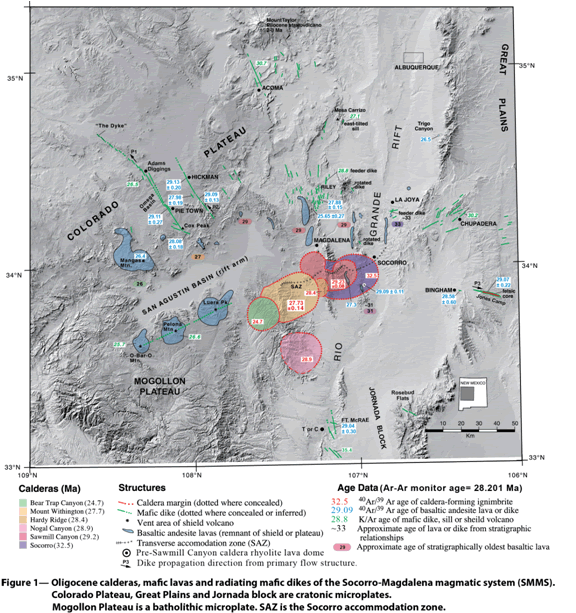
Socorro Caldera
The Socorro Caldera is a large volcanic collapse structure, 12 miles in diameter, that is partly exposed in the mountains southwest of Socorro. The Socorro caldera erupted over 250 cubic miles of mushy rhyolitic (granitic) magma as explosive crystal-rich pryoclastic flows, probably in a few weeks or months. Following its collapse, the Socorro caldera was then quiescent for 1.5 million years, which suggests that the underlying magma system “froze up” (crystallized to granite) shortly after the large volume eruption at 32.5 Ma.

The Socorro caldera is the oldest of a cluster of westward migrating calderas that formed between 32.5 and 24.7 million years ago, collectively known as the Socorro-Magdalena caldera cluster (SMCC). The SMCC forms the core of a large volume (1700 cubic miles) magmatic system of Oligocene age known as the Socorro-Magdalena magmatic system, SMMS. Relatively precise 40Ar/39Ar age determinations (0.4-1.0 % error) of long basaltic dikes that radiate outwards from the SMCC now provide a strong genetic link between mafic dikes of the large diameter the Magdalena radial dike swarm (MRDS) and the Oligocene caldera cluster at its core. Ongoing dating and field studies of dikes in the MRDS may help understand the dynamics of lateral propagation of dike-induced seismic swarms that are known to occasionally occur adjacent to restless calderas, such as Yellowstone and the Long Valley caldera. Figure 1 (below) is a map of the Socorro Magdalena magmatic system (SMMS) that shows currently available Ar-Ar age data (2012) for the Magdalena radial dike swarm and other components of the SMMS.Richard, along with colleagues Bill McIntosh and Chuck Chapin, recently presented an interpretation of the Oligocene Socorro-Magdalena magmatic system as a "miniplume" at the Penrose Conference, "Plume IV: Beyond the Plume Hypothesis", in Hveragerdi, Iceland. This extended abstract is available at http://www.mantleplumes.org. PDF’s of recent publications and posters can be obtained by sending an email request to Richard.


